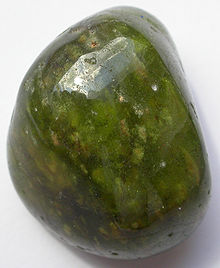- Vesuvianite
-
Vesuvianite 
Vesuvianite from the Jeffrey Mine in Asbestos, QuebecGeneral Category Mineral Chemical formula Ca10(Mg, Fe)2Al4(SiO4)5(Si2O7)2(OH,F)4 Crystal symmetry Tetragonal 4/m 2/m 2/m Unit cell a = 15.52 Å, c = 11.82 Å; Z = 2 Identification Color Yellow, green, brown; colorless to white, blue, violet, bluish green, pink, red, black, commonly zoned Crystal habit Short pyramidal to long prismatic crystals common, massive to columnar Crystal system Tetragonal Twinning Fine twin domains observed Cleavage Poor on {110} and {100} very poor on {001} Fracture Sub conchoidal to irregular Mohs scale hardness 6 - 7 Luster Vitreous to resinous Streak White Diaphaneity Subtransparent to Translucent Specific gravity 3.32 - 3.43 Optical properties Uniaxial (-) Refractive index nω = 1.703 - 1.752 nε = 1.700 - 1.746 Birefringence 0.004-0.006 Pleochroism slight in colored varieties Solubility Vesuvianite is virtually insolouble in acids Other characteristics striated lengthwise References [1][2] Vesuvianite, also known as idocrase, is a green, brown, yellow, or blue silicate mineral. Vesuvianite occurs as tetragonal crystals in skarn deposits and limestones that have been subjected to contact metamorphism.[2] It was first discovered within included blocks or adjacent to lavas on Mount Vesuvius, hence its name.
A bluish variety known as cyprine has been reported from Franklin, New Jersey and other locations; the blue is due to impurities of copper. Californite is a name sometimes used for jade-like vesuvianite, also known as California-, American- or Vesuvianite-jade. Xanthite is a manganese rich variety. Wiluite is an optically positive variety from Wilui, Siberia. Idocrase is an older synonym sometimes used for gemstone-quality vesuvianite.
References
- Deere, W. A. et al., 1962, Rock Forming Minerals: Vol. 1 Ortho- and Ring Silicates, pp. 113 - 120
- Webmineral data
- Vesuvianite at Franklin -Sterling
- Mindat - Cyprine var. w/ location data

This article about a specific silicate mineral is a stub. You can help Wikipedia by expanding it.

